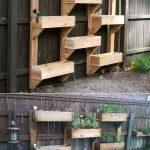Looking to spruce up your garden? Look no further. In this article, we will explore various fencing ideas for gardens and how they can enhance the overall aesthetics of your outdoor space. A well-chosen garden fence can not only provide a sense of security and privacy but also contribute to the design and style of your garden.
When it comes to fencing ideas for gardens, there are numerous options to consider. From traditional wooden fences to modern metal designs, each material offers its own unique benefits and drawbacks. Additionally, different fence styles such as picket, lattice, privacy, and decorative fencing can greatly impact the look and feel of your garden.
Whether you prefer to roll up your sleeves and tackle a DIY project or enlist the help of a professional, choosing the right fencing for your garden is an essential part of its overall design. By exploring different types of fencing materials, styles, installation options, and maintenance tips, you’ll be well-equipped to transform your garden into a beautiful and functional outdoor space.
Types of Fencing Materials
When it comes to choosing the right fencing materials for your garden, there are several options to consider. Each material has its own unique benefits and drawbacks, so it’s important to weigh these factors before making a decision. Here are some of the most common types of fencing materials for gardens:
- Wood: Wood is a classic choice for garden fencing, offering a timeless and natural look. With options like cedar, pine, or redwood, wood fences can be stained or painted to match your garden’s aesthetic. However, wood fencing requires regular maintenance and is susceptible to rot and pest damage if not properly cared for.
- Metal: Metal fences, such as wrought iron or aluminum, are durable and long-lasting. They offer a sleek and modern appearance while providing security and protection for your garden. On the downside, metal fences can be prone to rust and may require periodic maintenance to keep them looking their best.
- Vinyl: Vinyl fencing is a low-maintenance option that is easy to install and comes in a variety of styles and colors. It is resistant to rot, fading, and decay, making it an ideal choice for homeowners looking for a hassle-free fencing solution. However, vinyl fences can be more costly upfront compared to other materials.
- Composite Materials: Composite fencing combines wood fibers with plastic polymers to create a durable and environmentally-friendly alternative. This type of fencing mimics the look of wood while offering the low maintenance benefits of vinyl. While composite materials may come at a higher cost initially, they are long-lasting and require minimal upkeep over time.
When considering fencing ideas for gardens, it’s important to take into account the specific needs of your space as well as your personal style preferences. Whether you prioritize aesthetics or practicality, there are various options available to suit your specific requirements.
Garden Fence Styles
When it comes to choosing the right fencing for your garden, there are various styles to consider, each with its own unique design features and benefits. Understanding the different types of garden fence styles can help you make an informed decision that not only complements your overall garden design but also serves its intended purpose.
Here are some common garden fence styles to consider:
- Picket Fencing: This classic style is known for its charming, traditional look. Picket fences are typically made of wood and feature evenly spaced vertical boards with rounded or pointed tops. They’re great for creating a welcoming and inviting boundary for your garden.
- Lattice Fencing: Lattice fences are designed with crisscrossed wooden or vinyl panels, providing an elegant and decorative touch to any garden. These fences add a sense of privacy while still allowing light and air to pass through, making them perfect for creating a cozy outdoor space.
- Privacy Fencing: As the name suggests, privacy fences are ideal for creating seclusion and security in your garden. These fences are typically taller than other styles, blocking views from neighbors or passersby. Materials like wood, vinyl, or composite can be used to create a sleek and modern look while offering maximum privacy.
- Decorative Fencing: For those looking to add visual interest and style to their gardens, decorative fencing is the way to go. This style encompasses various designs such as ornamental iron, horizontal slats, or even intricate patterns. Decorative fencing creates a focal point in your garden while still serving its practical purpose.
These are just a few examples of the many fencing ideas for gardens that you can explore when considering the style of fence that best suits your outdoor space. Whether you’re going for a rustic cottage feel or a contemporary look, there’s a garden fence style out there to match your aesthetic preferences.
DIY Fencing Projects
Taking the do-it-yourself (DIY) approach to garden fencing can be a rewarding and cost-effective way to add a personal touch to your outdoor space. With the right materials, tools, and guidance, homeowners can successfully tackle their own fencing projects. Whether you’re looking to install a simple picket fence or a more elaborate decorative fence, there are steps you can follow to ensure a successful outcome.
Before embarking on a DIY fencing project, it’s important to carefully plan and measure the area where the fence will be installed. This will help determine the amount of materials needed and ensure that the fence is installed in the correct location. Additionally, checking with local ordinances or homeowner’s associations for any regulations or restrictions on fence height and design is crucial before beginning any work.
When it comes to choosing the right materials for your DIY garden fencing project, options range from affordable wood to low-maintenance vinyl or metal. Each material has its own set of pros and cons in terms of durability, maintenance requirements, and aesthetic appeal. For those looking for eco-friendly alternatives, composite materials made from recycled plastics and wood fibers are also becoming increasingly popular.
Aside from following standard safety precautions when working with tools and materials, homeowners should also consider enlisting help from friends or family members when tackling larger fencing projects. While DIY garden fencing can be a fulfilling endeavor, it’s important to assess one’s skills and resources before taking on more complex designs or structural elements.
| DIY Fencing Project Steps | Materials Needed |
|---|---|
| Carefully plan and measure the area for the fence installation. | Fence panels/posts, screws/nails, post hole digger |
| Check local regulations/restrictions on fence height/design. | Level, string line/tape measure |
| Select appropriate fencing material based on budget/preferences. |
By offering step-by-step guides such as this one for DIY garden fencing projects, homeowners can feel confident in creating a custom-designed space that reflects their personal style while enhancing the overall appeal of their gardens.
Professional Installation
When choosing a contractor for garden fence installation, it is important to consider several factors. Homeowners should seek recommendations from friends, family, or neighbors who have had positive experiences with fence installation professionals. Researching online reviews and checking references can also provide insight into the quality of work and customer satisfaction provided by different contractors.
It’s essential to obtain multiple quotes from different contractors to compare pricing, services offered, and timelines for completion. It’s also crucial to verify that the contractor has proper licensing and insurance to protect both the homeowner and the workers involved in the project. Ultimately, hiring a professional for garden fence installation can ensure a high-quality result that enhances the overall appearance and functionality of the outdoor space.
| Benefits of Professional Installation | Tips for Choosing a Contractor |
|---|---|
| Expertise in addressing challenges | Seek recommendations from trusted sources |
| Compliance with local regulations | Research online reviews and references |
| Quality workmanship for longevity | Obtain multiple quotes for comparison |
Fencing for Specific Garden Styles
When it comes to designing a garden, the style and theme play a crucial role in determining the overall look and feel of the space. The choice of fencing can greatly impact how well the garden design is executed. Different garden styles call for different fencing ideas that complement their theme and aesthetic. Whether you have a modern, cottage, natural, or formal garden, there are specific fencing options that can enhance the beauty of your outdoor space.
Modern Gardens
For modern gardens, sleek and minimalistic fencing options work best. Consider using materials such as metal or composite for a contemporary look. Horizontal slat fencing or glass panels can also provide a stylish and streamlined appearance.
Cottage Gardens
In contrast to modern gardens, cottage gardens often have a more quaint and charming aesthetic. For this type of garden, consider using picket fences or wooden lattice fencing to create a cozy and inviting atmosphere.
Natural Gardens
Natural gardens focus on embracing the beauty of the natural landscape. When it comes to fencing for this style of garden, consider using materials that blend seamlessly with the surroundings, such as bamboo or timber. Living fences made of hedges or climbers can also create a soft and organic boundary for natural gardens.
Formal Gardens
Formal gardens are known for their structured layouts and symmetrical designs. To complement this style, opt for elegant wrought iron fences or ornate metal railings to create a sense of sophistication and grandeur within the garden space.
By selecting fencing materials and styles that align with the specific theme of your garden, you can elevate its overall design while creating a cohesive visual appeal that enhances the beauty of your outdoor oasis. Explore various options to find the perfect fencing ideas for your garden’s unique style.
Maintenance and Care
When it comes to maintaining and caring for garden fencing, different materials require different levels of attention. Proper maintenance not only ensures the longevity and durability of the fence but also contributes to the overall appearance of the garden. Here are some tips for taking care of various types of garden fencing:
Wood Fencing
Wood fencing is a popular choice for many gardens due to its natural and timeless look. However, it requires regular maintenance to prevent rotting, warping, and insect damage. To maintain a wood fence, it is important to inspect it regularly for any signs of wear or damage. Cleaning the fence with a mild detergent and water and applying a protective sealant or stain can help prolong its lifespan.
Metal Fencing
Metal fences, such as wrought iron or aluminum, are known for their durability and low maintenance requirements. However, they may still require occasional cleaning and rust prevention. Regularly washing metal fencing with soapy water and inspecting for any signs of rust or corrosion can help keep them in good condition.
Vinyl Fencing
Vinyl fences are touted for being low-maintenance and durable. They are resistant to rotting, fading, and insect damage. Simply rinsing off dirt with water and using mild soap as needed can keep vinyl fencing looking great. Periodic inspections for any cracks or damage are also recommended.
By properly maintaining different types of garden fencing, homeowners can ensure that their investment lasts for years to come while keeping their outdoor space looking beautiful.
In addition to regular maintenance tasks, it is also crucial to address any repairs promptly before they escalate into major issues that could compromise the structural integrity of the fence.
Creative Fencing Ideas
In conclusion, when it comes to fencing ideas for gardens, there is a wide array of options available to homeowners that can not only provide security and privacy but also enhance the overall aesthetic appeal of their outdoor space. From traditional materials like wood and metal to innovative concepts like vertical gardens and living fences, the possibilities are virtually endless.
By carefully considering the specific needs, style, and theme of their garden, homeowners can choose a fencing option that perfectly complements their outdoor oasis.
For those looking for environmentally friendly options, eco-friendly alternatives such as recycled composite materials or sustainably sourced wood can be excellent choices. These not only minimize the environmental impact but also add a unique touch to the garden area. Additionally, incorporating living fences with climbing plants or creating vertical gardens using trellises can add a vibrant and natural element to the garden while serving as an attractive and functional fencing solution.
Ultimately, whether opting for DIY projects or seeking professional installation services, it’s essential for homeowners to prioritize proper maintenance and care for their garden fencing. Regular upkeep will ensure the longevity and durability of the fencing materials, preserving both their functionality and beauty for years to come. With careful consideration and creativity, fencing in gardens can serve not only as a practical feature but also as an integral part of the overall design scheme.
Frequently Asked Questions
What Is the Cheapest Fencing for Garden?
The cheapest fencing option for a garden typically includes materials like chain-link or wire fencing. These types of fences are affordable and easy to install, making them a budget-friendly choice for enclosing a garden.
What Is the Best Kind of Fence for a Garden?
The best kind of fence for a garden often depends on the specific needs of the gardener. For those looking for aesthetics and privacy, wooden fences are a popular choice. However, for durability and low maintenance, vinyl or aluminum fencing may be preferred.
What Is the Cheapest Option for Fencing?
When considering cost, the cheapest option for fencing usually involves materials such as chain-link, wire, or certain types of wood. It’s important to balance affordability with other factors like durability and maintenance when selecting the best fencing option for your needs.

Welcome to my gardening blog! I am passionate about plants and enjoy sharing my knowledge and experiences with others. In this blog, I will write about everything related to gardening, from tips on how to get started to updates on my own garden projects.





